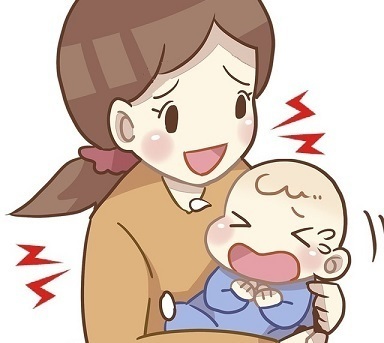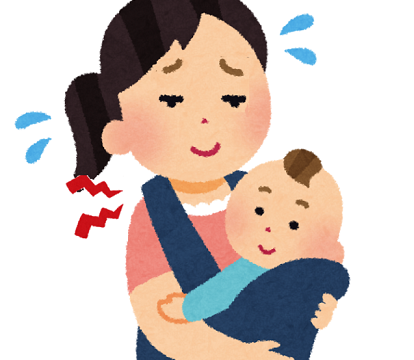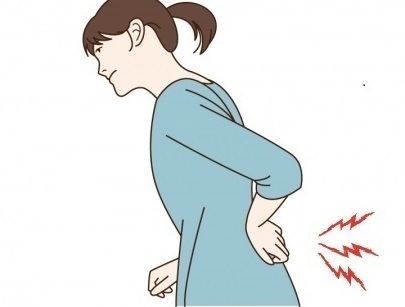Three major symptoms of After childbirth troubles
3 major symptoms of After childbirth troubles
・Carrying a baby is not easy-going
After childbirth, women are worried that "The burden of carrying a baby every day" is unavoidable during Child-rearing.
Present day women have slender bodies. One day, they will suddenly experience pain that have never felt before, and it will cause as "pain from carrying baby" that interferes with child rearing.
During pregnancy and childbirth damage have remained in the neck, shoulders, and lower back, worsening (or frequently) the symptoms that originally worried them.
It is true that men are making progress in supporting child-rearing, but the trouble of women cannot be reduced easy even with follow-up.
・The Importance of Physical Support
・The Importance of Physical Support
Women suffer from Carrying a baby do not want to avoid Carrying so far as reducing physical affection with their baby. they want to make their own bodies that they Carrying as fit as possible.
However, mental advice will not relieve the pain caused by carrying. they need support physical support. (It's not that they want to relax or have people understanding, it's just that want own physical pain to be relieved so that can focus on child-rearing.)
There are still not enough services to support the physical needs of women raising children. It should be recognized as a necessary care, not a treat myself.
◆The three major symptoms caused by carrying a baby
The three major symptoms caused by carrying a baby are shoulder pain, neck pain, and low back pain.
Each of the three major symptoms has its own trigger, and there are different approaches to relieving the symptoms and the basis for decision making when taking criteria.
In many cases, knee pain, headache, and dizziness may also occur, which may lead to problems beyond the pain of carrying.
| Symptom | Trigger |
| Carrying shoulder scapula | unfamiliar carrying, one-handed carrying Tendon sheath |
| Carrying neck | oblique angle of the neck,Angle of the neck pressure from the carrying strap |
| Carrying low back | Sitting upright, sitting cross-legged |
Carrying a baby (housework, get around, etc.) is an unavoidable part of child-rearing.
If you start experiencing unpleasant symptoms, you need to pay attention. You may have caused shoulder pain from carrying your baby. It is important to stop the progression of the symptoms of "while carrying".
1-1 Causes of "The shoulder pain of Carrying"

One-handed carrying, breastfeeding, nursing, etc.
Due to unstable posture when carrying a baby, overuse of one arm due to housework while carrying, or while sleeping with a baby (nursing, etc.), the burden on the shoulder and scapula becomes daily basis, and the symptoms progress to become pain.
In the beginning, the pain was limited to the arms, but it gradually widens and may lead to numbness in the hands accompanied by pain in scapula and back.
| Shoulder angle | When you are not used to carrying baby, you tend to carry forcibly using only your arms. That can lead to an imbalance in the height of scapula on both sides. |
| One-handed carrying | One-handed carrying is often used for housework and movements, but it puts more burden on the shoulders than both carrying. if you carrying with your dominant hand while doing housework with the opposite hand, the shoulder that you unconsciously support is more likely to suffer pain. |
| Tendon sheath of wrist | It is easy to develop tendinitis in the wrist during child-rearing. When the wrist is injured, carrying in a way that covers the wrist becomes an unnatural posture, which can cause further shoulder pain. |
1-2 Dealing with "The shoulder pain of Carrying"
As "Kori" in the shoulders progresses and limits the range of motion, it becomes a vicious circle that your stretching and exercises are not effective.
In order to stop this vicious cycle, it will do the following in order: "Loose up pectoral muscles and upper arms" → "Loose up of scapula" → "Correction of scapula". Those purpose the range of motion to the stage that self-recovery can be expected.
If the burden caused by carrying a baby becomes less than the self-recovery, pain can be prevented while carrying.
| Loosen up pectoral muscles and upper arms | Loosen up Powerful pectoral muscles that support the shoulders, along the lines of the muscle fibers. Should pay special attention to the upper arms and clavicle that connect the shoulder joint. |
| Loosen up of scapula | Check to see if scapula is pulled inside stiffly or pushed outside stiffly. loosen up scapula from a 360-degree angle. |
| Correction of scapula | The range of motion is checked, and correction is performed using a combination of scapular rotation and traction. In the scapula rotation, the range of motion is gradually increased by using the weight of the arm and the principle of leverage of the shoulder joint. |
Low posture child-rearing for babies, such as diaper changing and feeding, can lead to a daily basis look down angle that increases the strain on the neck.
In addition, although improvements have been made in baby carriers over the years, carrying the baby on the front side causes a slouching posture due to the weight of the baby. stiffed shoulders and bending are often seen.
By postpartum care, it must prevent the progression of symptoms that cannot be avoided with child-rearing.
2-1 Causes of "The neck pain of Carrying"

Front carrying, height of infant
Look down angle to see your baby and the burden of carrying a baby on the front side can trigger neck's "Kori".
Child-rearing, which continues every day without a break, gradually cause new "Kori" before it can't recovers.
| the angle at your neck look down | When you focus on your baby and look down for a long time, the weight of the head (about 5 kg) is placed on the neck. Without realizing it, "Kori" that stiffens the neck from the bottom of the occipital bone to the back of the neck accumulates as if it were sticking to the neck. |
| Front Carrying | When the pressure of front carrying causes for a prolonged period of time, the burden at the base of the neck reduces the circulation of arteries and veins. Especially near the cervical vertebrae, No.7, it leads to "Kori" similar to neck of slouching, which is raised and stiffens around the cervical prominences. |
2-2 Dealing with "The neck pain of Carrying"
As the neck twists and makes complex up, down, left and right movements, the muscles in the neck that play different roles exist at perfect intervals that do not interfere with each other's movements.
"Kori" in the neck causes imbalance in the spacing of the muscles and movement in the entire neck.
There are many therapies and health tools that advertise to solve all neck discomforts with traction, but only stretching the spacing between the vertebrae is not solve.
It is more important to even spacing of the seven cervical vertebrae.
| Loosen up back of neck | "Kori" of the lines at back of neck (lower occipital, lower or lateral cervical vertebrae, and base of the neck) leads to imbalance in movement. for that loosen up all. The neck have complex muscular tissue with different angles and shapes, so it is necessary to avoid a single pattern of loosen up. The direction of loosen up should be changed that back or prone, up or down, left or right. |
| 3-point for neck traction | To avoid the instinctive stiffness of the neck caused by traction, we use technique that combine normal neck traction and a feint to the brain. Start with a small movement to lightly lift the cervical vertebrae with one finger, and then move on to a larger movement from the cervical to the sacral vertebrae. |
| Figure eight | After stretching the spacing of the cervical vertebrae with neck traction, add a movement to even spacing of the neck. This is the figure-eight movement of the cervical spine. It is a combination of cervical compression and release, and figure eight movement (∞ movement) to equalize the left, right, up, down. It is a technique to smoothen the nerve transmission as well as the muscles. |
For those who have returned to an unstable pelvic position after childbirth, or have experienced back problems (such as strained back or sciatica) before, the lower back may not be able to bear the weight of the baby.
Present day women are slender style and lack of exercise after childbirth. that can cause a significant decline in muscle strength and joints, which is essential in preventing back pain.
For Postpartum care correct pelvic and loosen up low back to prevent back pain. In addition, exercises that can be done while raising children will be taught to prevent back pain.
3-1 Causes of "The low back pain of Carrying"

Putting child to bed, giving a piggyback ride, etc.
Women with pelvic instability due to childbirth and back discomforts before have reduced endurance in lower back, which increases risk of developing low back pain from carrying.
In addition, as a baby's weight double in 6 months, the burden of carrying advances faster than a woman's muscle development. (The burden of carrying an infant > a woman's muscle strength.)
| Postpartum pelvic position | The ideal pelvis is the height of ilium is aligned on both sides and there is no tilt or twist. (when pelvis is placed on a flat surface, it is stable and does not fall down.) If pelvis does not return to its original position when after pregnancy or childbirth, or if the position it returns to is shifted, the pelvic distortion will worsen. The distortion of pelvis from before childbirth may progress further. |
| Discomfort before childbirth | If you have experienced a strained back or sciatica before childbirth, the endurance of your lower back may be reducing. |
| Women's Style | The slender style of present women can have a hard time carrying a baby. Even if their body look sturdy, their actual muscle ratio is low, especially late 30s or later. |
2-2 Dealing with "The low back pain of Carrying"
The basic idea is to avoid concentrating the burden to lower back due to carrying a baby and to take preventive measures in advance.
In addition, it is not enough to approach lower back pain in only one way, it necessary to in multiple ways.
| Postpartum pelvic correction and S.O.T | The combination of pelvic correction and S.O.T creates a balance where the burden is not concentrated in one place. In the postpartum pelvic correction, the height of iliac and left-right bias (twisting) are adjusted using manipulative techniques. In S.O.T, the sacrum contains the center of gravity, is adjusted to a position that stabilizes body core. |
| Loosen up low back | Other symptoms that such as coccyx pain and sciatica, tend to misunderstanding with lower back pain. By focusing on lower back and bottom loosen up, the suspected symptoms can be covered. Although coccyx pain in women is relatively common, there is not much progress in dealing with. |
| Improvement of bent back | The longer a person has been swayback posture, they are almost unaware of own body shift. By resetting the posture and trying correct it, you will imprint a way of balancing that is not sway back. |
| Postpartum Training | Gradually start training after 1 month postpartum to prevent low back pain. We recommend core abdominal training, which is simple and short, yet effective. Guide to preventing back pain is to do 5 abdominal exercises without supporting your legs. |

Conclusions
It is not realistic to stop "carrying a baby" just because three major symptoms caused by the carrying have appeared.
Measures daily-basis carrying are required for each part of body where those symptoms occur.
It is important to take a specific approach that combines postpartum pelvic correction, relaxation, and training.